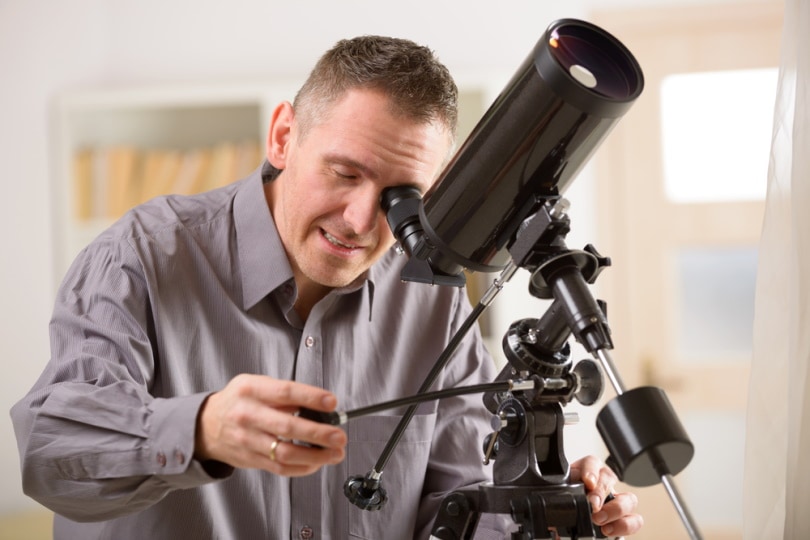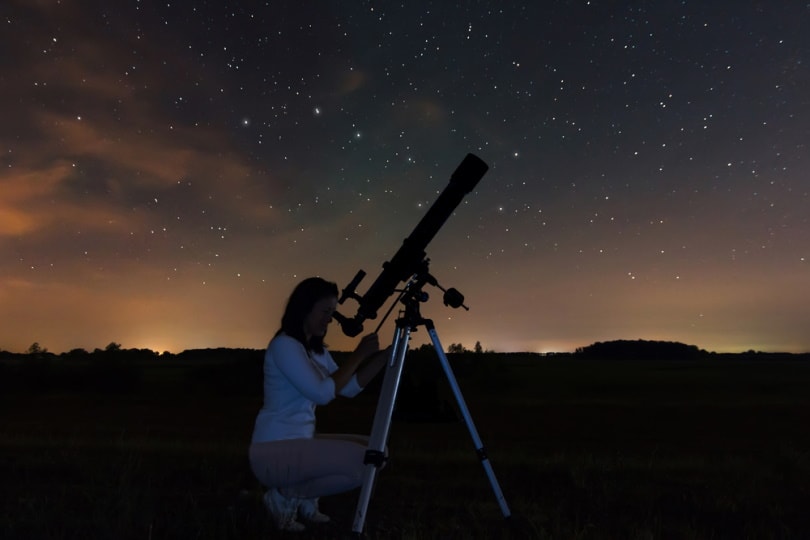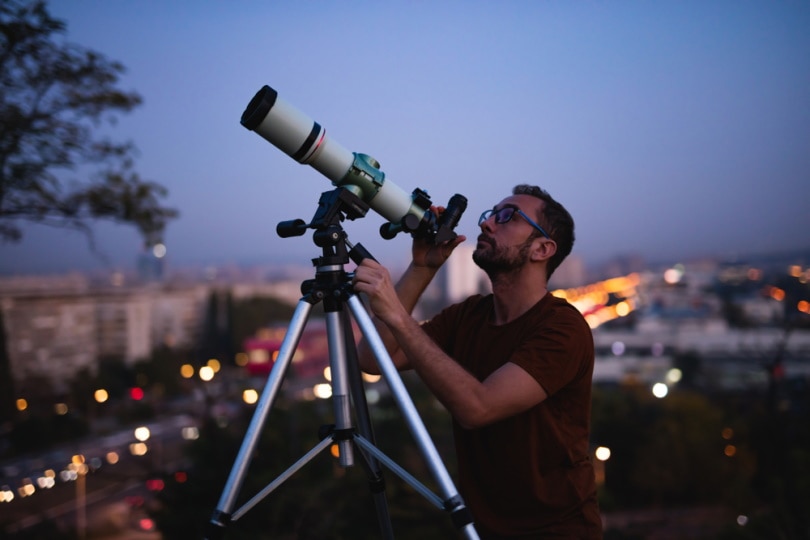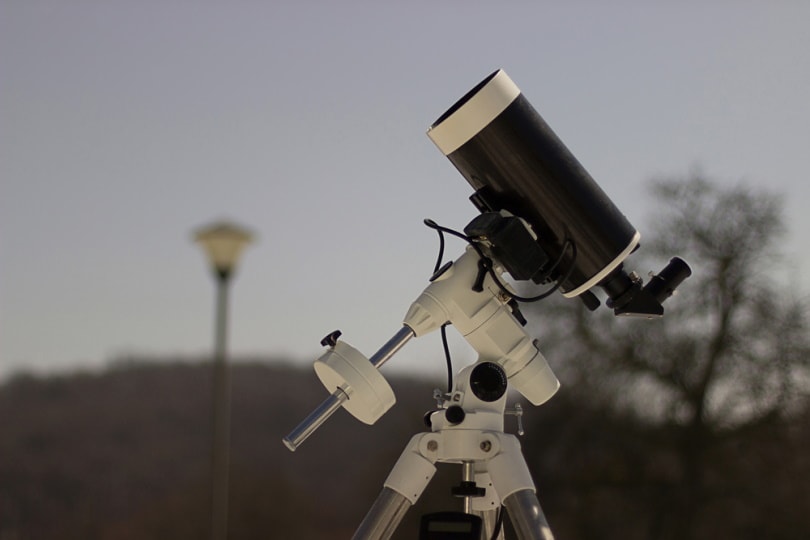8 Interesting Telescope Facts You Never Knew (2024 Updates)
Last Updated on

Since their invention in the 17th century, telescopes have forced mankind to change its perspective on the universe—repeatedly. As a primarily visceral creature, man bases his beliefs and understanding of his reality on what he can see, and anything that lets him see more or better changes the bedrock on which beliefs are founded.
Microscopes, physics, telescopes, and particle colliders are all examples of tools that force us to reexamine ourselves and our world. Here are some fun facts about the history and current state of telescopes – one of the earliest instruments that taught mankind how small we are in the great scheme of things.

The Top 8 Telescope Facts
1. Telescopes Were Invented in the Netherlands
The first record of a telescope is from 1608 when Hans Lippershey patented a device that came to be known as a refracting telescope. These are the earliest known and simplest sorts of telescopes, using an arrangement of two lenses to focus light in such a way as to make objects appear closer than they actually are. Two other inventors either applied for a patent or started selling telescopes at the same time, and the government determined that the design was simple enough to replicate they couldn’t offer a patient – but they saw the design was useful and paid Lippershey not only to make telescopes but develop paired telescopes that could be used as binoculars!

2. Telescopes Confirmed Heliocentric Theory
Galileo Galilei is well known for his theory that the earth revolved around the sun (heliocentrism), set against the prevailing theory at the time, which held that the sun revolved around the earth (geocentrism). Galileo was able to prove his theories using mathematics and observations from his first refracting telescope (capable of 3x magnification) and eventually refining them using observations from finer instruments. He was eventually able to make a telescope capable of 20x magnification – enough for him to observe Venus, Saturn (including the rings), sunspots, and a supernova.
Heliocentrism was closer to the truth, but there was much still to learn – for we now know that the heavenly bodies in the Solar System do not have perfectly circular orbits with the Sun at the center, and we know that the Solar System is not the center of the universe as we’ve observed it.
3. Optical Telescopes: All Glass, but Some Mirrors and Some Lenses
As we’ve mentioned, the first telescopes were refracting, meaning they bent light through a lens toward another lens to make it appear that objects far away looked nearer. The problem with using clear glass lenses is that light is not all collected and bent just the right way, meaning the part of the image gets lost. Isaac Newton discovered that mirrors can be used to collect even more light, and because no light goes through them, they can bend and collect much more of it much more accurately than clear glass lenses. These telescopes are called reflecting telescopes.
The very first reflecting telescope, made by Isaac Newton himself, exists today and is cared for by the Royal Society of London. Even the most sophisticated telescopes used today owe their design to his original work, including the orbital Hubble Space Telescope!

4. Powerful Telescopes are HUGE
To achieve greater magnification, telescopes must collect more light than the human eye does by itself. This means the telescopes must be much wider to collect the light, and much longer to be able to focus it on an eyepiece that can be used to concentrate all the collective light into an image the human eye can focus on and see. As mankind has sought to look deeper and deeper into space, telescopes have gotten wider and longer. Some are absolutely gigantic. The Leviathan of Parsonstown, built in Ireland in 1845, weighed over 40 tons and was the largest telescope in the world for many years. Since then, it has been dwarfed by telescopes that are even larger, such as the Keck 1 and 2 telescopes that have individual mirrors weighing over 1 ton each (270 tons total weight per telescope).
Even though it had to be launched into space, the Hubble Space Telescope weighs over 12 tons, Is 43 feet in length, and 14 feet around.
Currently under construction is the ELT or Extremely Large Telescope. When complete, it will weigh 5000 tons (10 million pounds!) and collect 100 million times more light than the human eye. It will be able to see things in space that have been previously impossible to observe with smaller, less powerful telescopes. It is hoped it will be able to spot planets around other stars and even determine if planets/planet-like bodies have water or signs of molecules that indicate a greater chance of finding life!
5. Telescopes Have Many Uses
Nowadays telescopes are in use almost everywhere. The same principles behind a refracting telescope are in use in high-end camera lenses (called telephoto lenses), drone cameras, binoculars, rifle scopes, and similar arrays are used to focus light in many applications – from flashlights to laser pointers.

6. Chile Has the Most Large Telescopes
Of the ten largest telescopes, most are in Chile in the Atacama Desert. Humidity alters light as it travels through the air, and these deserts are extremely dry. They also boast some of the highest clear day counts of anywhere in the world, meaning that the air is clearer and the sky easier to see.
7. First Light
The very first time an astronomical telescope is pointed at the sky, the event is referred to as “First Light.”

8. Radio Telescopes – Looking for Aliens
Radio telescopes work much like optical telescopes, except they work on longer wavelengths than the light spectrum. Satellite dishes are a common example of radio antenna. They collect radio waves from a source on a large dish shaped to reflect those waves back on a small collection point, thus concentrating a large supply of waves in a small sensor. The SETI, or Search for Extraterrestrial Life, uses arrays of large radio telescopes to search the skies for radio waves that would indicate they came from an artificial source – that is, another life form.
- See also: What Is a Refractor Telescope?
Featured Image Credit: Monika Wisniewska, Shutterstock
Table of Contents
- The Top 8 Telescope Facts
- 1. Telescopes Were Invented in the Netherlands
- 2. Telescopes Confirmed Heliocentric Theory
- 3. Optical Telescopes: All Glass, but Some Mirrors and Some Lenses
- 4. Powerful Telescopes are HUGE
- 5. Telescopes Have Many Uses
- 6. Chile Has the Most Large Telescopes
- 7. First Light
- 8. Radio Telescopes – Looking for Aliens
About the Author Robert Sparks
Robert’s obsession with all things optical started early in life, when his optician father would bring home prototypes for Robert to play with. Nowadays, Robert is dedicated to helping others find the right optics for their needs. His hobbies include astronomy, astrophysics, and model building. Originally from Newark, NJ, he resides in Santa Fe, New Mexico, where the nighttime skies are filled with glittering stars.
Related Articles:
15 Crucial Facts About Ultraviolet Rays & the Sun
What Constellation Is Spica In? The Interesting Answer!
10 Interesting Leo Constellation Facts, Myths, and FAQs
15 Interesting Pegasus Constellation Facts, Myths, and FAQs
6 Interesting Sagittarius Constellation Facts, Myths, and FAQs in 2024!
What Are Constellations? Where Did They Come From?
8 Interesting Libra Constellation Facts, Myths, and FAQs
What Is Infrared Radiation? Science-Based Facts & FAQ
